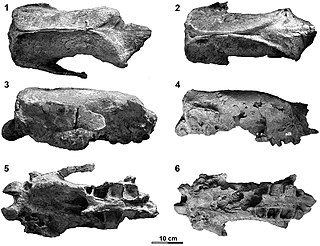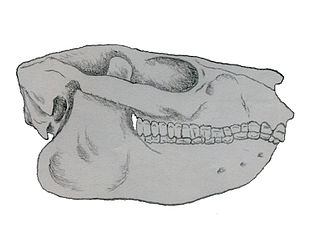
Peltephilus, the horned armadillo, is an extinct genus of dog-sized, armadillo xenarthran mammals which first inhabited Argentina during the Oligocene epoch, and became extinct in the Miocene epoch. Notably, the scutes on its head were so developed that they formed horns. Aside from the horned gophers of North America, it is the only known fossorial horned mammal.

Theosodon is an extinct genus of litoptern mammal from the Early to Middle Miocene of South America.

Adinotherium is an extinct genus of Toxodontidae, large bodied hoofed ungulates which inhabited South America during the Middle to Late Miocene, from 17.5 to 6.8 Ma and existed for approximately 10.7 million years, Santacrucian to Huayquerian in the South American land mammal ages (SALMA). Fossils of Adinotherium have been found in the Santa Cruz and Ituzaingó Formations of Argentina and the Chucal and Río Frías Formations of Chile.
The zygomasseteric system in rodents is the anatomical arrangement of the masseter muscle of the jaw and the zygomatic arch of the skull. The anteroposterior or propalinal (front-to-back) motion of the rodent jaw is enabled by an extension of the zygomatic arch and the division of the masseter into a superficial, lateral and medial muscle. The four main types are described as protrogomorphous, sciuromorphous, hystricomorphous, and myomorphous.
Parapropalaehoplophorus septentrionalis was a comparatively small species of glyptodont, extinct relatives of the modern armadillo. The mammal, identified in 2007 from the fossilized remains of a specimen found in 2004, weighed approximately 200 pounds and had a shell covered by tiny circular bumps. It lumbered around northern Chile in the Chucal Formation, an area now dominated by the Andes mountain range, some 18 million years ago. Fossils of the glyptodont also have been found in Peru.

Mesotheriidae is an extinct family of notoungulate mammals known from the Oligocene through the Pleistocene of South America. Mesotheriids were small to medium-sized herbivorous mammals adapted for digging.

Nesodon is a genus of Miocene mammal belonging to the extinct order Notoungulata which inhabited southern South America during the Late Oligocene to Miocene living from 29.0 to 16.3 Ma and existed for approximately 12.7 million years. It had a relatively large size, weighing up to 554 kg (1221 lbs) and reaching 1.5 m in height.

Paedotherium is an extinct, potentially paraphyletic genus of Notoungulate, belonging to the family Hegetotheriidae, composed of small-sized, rodent or lagomorph-like South American ungulates. Four species are unambiguously recognized, from the Late Miocene to the Pleistocene of Argentina, and from the late Miocene of Bolivia and Chile.
Fiandraia is an extinct monotypic genus of notoungulate that lived in Uruguay during the Oligocene and the Early Miocene. It was found in the Fray Bentos Formation, in rocks dated back from the Deseadan period.
Ethegotherium is an extinct genus of Notoungulates, belonging to the suborder Typotheria. It lived from the Lower to the Middle Miocene, and its fossilized remains were discovered in South America. It might be a synonym of the genus Prohegetotherium.
Transpithecus is an extinct genus of Notoungulates, belonging to the suborder Typotheria. It lived during the Middle Eocene in what is today South America.

Pseudotypotherium is an extinct genus of Notoungulates, belonging to the suborder Typotheria. It lived from the Late Miocene to the Late Pliocene, and its fossilized remains were discovered in South America.
Ignigena is an extinct genus of notoungulate belonging to the family Interatheriidae. The only known species of this genus is Ignigena minisculus. The genus name means born from the fire, referencing the volcanic deposits in which its fossils were found, while the type species name minisculus means "minuscule", referencing the small size of the animal. It was related to Johnbell. I. minisculus was a small animal with elongated teeth. Its fossilized remains were found in Chile, in deposited dating to the Early Eocene.

Proeremotherium is an extinct genus of megatheriine ground sloths in the family Megatheriidae. It lived during the Late Miocene and Early Pliocene of what is now Venezuela. So far, two largely complete skulls have been recovered in the Falcón Basin in Venezuela. The finds identify the animals as medium-sized representatives of the Megatheriidae. In the cranial anatomy, Proeremotherium resembles the later and giant Eremotherium. It is therefore assumed that the two ground sloths are directly related to each other.
Archaeopithecus is an extinct genus of Notoungulate, belonging to the suborder Typotheria. It lived during the Middle Eocene, in what is today Argentina.
Colbertia is an extinct genus of oldfieldthomasiid notoungulate. It lived from the Early to the Middle Eocene, and its fossilized remains were discovered in Argentina and Brazil.
Ultrapithecus is an extinct genus of oldfieldthomasiid notoungulate that lived during the Middle Eocene of what is now Argentina.
Altitypotherium is an extinct genus of Notoungulate, belonging to the suborder Typotheria. It lived during the Early Miocene, and its fossilized remains were discovered in South America.

Notopithecus is an extinct genus of Notoungulate, belonging to the suborder Typotheria. It lived from the Middle to the Late Eocene and its fossilized remains were discovered in South America.
Nanolophodon is an extinct genus of mammal, belonging to the order Notoungulata. It lived during the Early Eocene, and its fossilized remains were discovered in what is now Brazil.

















